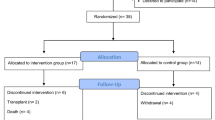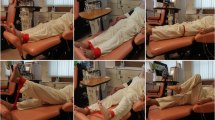Abstract
Purpose
This study aimed to evaluate the effects of 7-month intradialytic exercise training (IDE) on vastus lateralis (VL) muscle architecture, functional capacity and quality of life in stable haemodialysis (HD) patients.
Methods
44 HD patients were randomly assigned into an Exercise Group (EG = 21), which they received 7 months of IET, at 60% of pre-assessed maximum aerobic power, 3/week) or into a Control Group (CG = 23, no exercise). VL architecture was evaluated with ultrasonography, functional capacity was assessed using a series of functional tests (6 min walking test, 5 repetitions sit-to-stand, sit-to-stand 60 s, handgrip strength), and maximal aerobic power determined with a modified version of the Åstrand test. Quality of life and fatigue levels were evaluated using validated questionnaires.
Results
VL fascicle angle and length did not change significantly in both groups (P > 0.05). Muscle thickness decreased in CG (P = 0.02) while it was fully preserved in the EG. Functional capacity increased only in the EG (6 min walking test 15.79 ± 12.35%, P < 0.001; max aerobic power 26.36 ± 1.24%, P < 0.001; STS-60rep: 10.23 ± 1.60%, P < 0.000; hand grip strength: 5.14 ± 28.30%, P < 0.02).
Conclusion
Intradialytic aerobic exercise training, improves functional capacity and prevents thigh muscle mass loss in HD patients. It is evident that muscle ultrasonography could play a pivotal role in assessing muscle quality changes in haemodialysis patients. A higher level of training intensity or combination with resistance exercises may be required to further improve anabolism and influence muscle architecture in this patient population.
Clinical Trial Registry number
NCT03905551.


Similar content being viewed by others
Availability of data and materials
The datasets of the current study are available from the corresponding author on reasonable request.
References
Sakkas G, Sargeant A, Mercer T, Ball D, Koufaki P, Karatzaferi C et al (2003) Changes in muscle morphology in dialysis patients after 6 months of aerobic exercise training. Nephrol Dial Transplant 18:1854–1861
Ju A, Unruh M, Davison S, Dapueto J, Dew MA, Fluck R et al (2018) Establishing a core outcome measure for fatigue in patients on hemodialysis: a standardized outcomes in nephrology-hemodialysis (SONG-HD) consensus workshop report. Am J Kidney Dis 72(1):104–112
Chen CT, Lin SH, Chen JS, Hsu YJ (2013) Muscle wasting in hemodialysis patients: new therapeutic strategies for resolving an old problem. Sci World J 5:6–7
Sakkas GK, Ball D, Mercer TH, Sargeant AJ, Tolfrey K, Naish PF (2003) Atrophy of non-locomotor muscle in patients with end-stage renal failure. Nephrol Dial Transplant 18(10):2074–2081
Johansen KL, Delgado C, Kaysen GA, Chertow GM, Chiang J, Dalrymple LS et al (2019) Frailty among patients receiving hemodialysis: evolution of components and associations with mortality. J Gerontol A Biol Sci Med Sci 74(3):380–386
Storer TW, Casaburi R, Sawelson S, Kopple JD (2005) Endurance exercise training during haemodialysis improves strength, power, fatigability and physical performance in maintenance haemodialysis patients. Nephrol Dial Transplant 20(7):1429–1437
Stenvinkel P, Carrero JJ, von Walden F, Ikizler TA, Nader GA (2016) Muscle wasting in end-stage renal disease promulgates premature death: established, emerging and potential novel treatment strategies. Nephrol Dial Transplant 31:1070–1077
Cheema B, Abas H, Smith B, O’Sullivan A, Chan M, Patwardhan A et al (2007) Randomized controlled trial of intradialytic resistance training to target muscle wasting in ESRD: the Progressive Exercise for Anabolism in Kidney Disease (PEAK) study. Am J Kidney Dis 50(4):574–584
Cheema BS, Singh MA (2005) Exercise training in patients receiving maintenance hemodialysis: a systematic review of clinical trials. Am J Nephrol 25(4):352–364
Giannaki CD, Sakkas GK, Karatzaferi C, Hadjigeorgiou GM, Lavdas E, Kyriakides T et al (2013) Effect of exercise training and dopamine agonists in patients with uremic restless legs syndrome: a six-month randomized, partially double-blind, placebo-controlled comparative study. BMC Nephrol 11(14):194
Giannaki CD, Stefanidis I, Karatzaferi C, Liakos N, Roka V, Ntente I et al (2011) The effect of prolonged intradialytic exercise in hemodialysis efficiency indices. ASAIO J 57(3):213–218
Giannaki CD, Sakkas GK, Karatzaferi C, Hadjigeorgiou GM, Lavdas E, Liakopoulos V et al (2011) Evidence of increased muscle atrophy and impaired quality of life parameters in patients with uremic restless legs syndrome. PLoS ONE 6(10):1–7
Carrero JJ, Johansen KL, Lindholm B, Stenvinkel P, Cuppari L, Avesani CM (2016) Screening for muscle wasting and dysfunction in patients with chronic kidney disease. Kidney Int 90(1):53–66
Watson EL, Baker LA, Wilkinson TJ, Gould DW, Graham-Brown MPM, Major RW et al (2020) Reductions in skeletal muscle mitochondrial mass are not restored following exercise training in patients with chronic kidney disease. FASEB J 34(1):1755–1767
Lieber RL, Fridén J (2000) Functional and clinical significance of skeletal muscle architecture. Muscle Nerve 23(11):1647–1666
Lieber RL, Fridén J (2001) Clinical significance of skeletal muscle architecture. Clin Orthop Relat Res 383:140–151
Sabatino A, Regolisti G, Delsante M, Di Motta T, Cantarelli C, Pioli S et al (2019) Noninvasive evaluation of muscle mass by ultrasonography of quadriceps femoris muscle in End-Stage Renal Disease patients on hemodialysis. Clin Nutr 38:1232–1239
Timmins RG, Shield AJ, Williams MD, Lorenzen C, Opar DA (2016) Architectural adaptations of muscle to training and injury: a narrative review outlining the contributions by fascicle length, pennation angle and muscle thickness. Br J Sports Med 50(23):1467–1472
Jandova T, Narici MV, Steffl M, Bondi D, D’Amico M, Pavlu D et al (2020) Muscle hypertrophy and architectural changes in response to eight-week neuromuscular electrical stimulation training in healthy older people. Life (Basel) 10(9):184
Sawant A, Garland SJ, House AA, Overend TJ (2011) Morphological, electrophysiological, and metabolic characteristics of skeletal muscle in people with end-stage renal disease: a critical review. Physiother Can 63(3):355–376
Narici MV, Maganaris CN, Reeves ND, Capodaglio P (2003) Effect of aging on human muscle architecture. J Appl Physiol 95(6):2229–2234
Blazevich AJ, Gill ND, Bronks R, Newton RU (2003) Training-specific muscle architecture adaptation after 5-wk training in athletes. Med Sci Sports Exerc 35(12):2013–2022
Salimin N, Sazali MH, Azzfar MS, Nadzalan A (2018) Muscle architecture and exercise performance: a mini review. Biomed J Sci Tech Res 3(5):3555–3557
Schardong J, Dipp T, Bozzeto CB, da Silva MG, Baldissera GL, Ribeiro RC et al (2017) Effects of intradialytic neuromuscular electrical stimulation on strength and muscle architecture in patients with chronic kidney failure: randomized clinical trial. Artif Organs 41(11):1049–1058
Watson EL, Gould DW, Wilkinson TJ, Xenophontos S, Clarke AL, Vogt BP et al (2018) Twelve-week combined resistance and aerobic training confers greater benefits than aerobic training alone in nondialysis CKD. Am J Physiol Renal Physiol 1:F1188–F1196
Gould DW, Watson EL, Wilkinson TJ, Wormleighton J, Xenophontos S, Viana JL et al (2019) Ultrasound assessment of muscle mass in response to exercise training in chronic kidney disease: a comparison with MRI. J Cachexia Sarcopenia Muscle 10(4):748–755
Kouidi E, Albani M, Natsis K, Megalopoulos A, Gigis P, Guiba-Tziampiri O et al (1998) The effects of exercise training on muscle atrophy in haemodialysis patients. Nephrol Dial Transplant 13(3):685–699
Moore GE, Parsons DB, Stray-Gundersen J, Painter PL, Brinker KR, Mitchell JH (1993) Uremic myopathy limits aerobic capacity in hemodialysis patients. Am J Kidney Dis 22(2):277–287
Macdonald JH, Marcora SM, Jibani M, Phanish MK, Holly J, Lemmey AB (2005) Intradialytic exercise as anabolic therapy in haemodialysis patients—a pilot study. Clin Physiol Funct Imaging 25(2):113–118
Adams GR, Vaziri ND (2006) Skeletal muscle dysfunction in chronic renal failure: effects of exercise. Am J Physiol Renal Physiol 290(4):F753–F761
Johansen KL (2007) Exercise in the end-stage renal disease population. J Am Soc Nephrol 18(6):1845–1854
Huang HJ, Ferris DP (2009) Upper and lower limb muscle activation is bidirectionally and ipsilaterally coupled. Med Sci Sports Exerc 41(9):1778–1789
Yabe H, Kono K, Shiraki R, Masuda A, Moriyama YY, Kasuga H (2020) Relationship between blood pressure response during hemodialysis and exercise tolerance or heart rate recovery measured using cardio-pulmonary exercise testing in maintenance hemodialysis patients. Ren Replace Ther 6(4):895
Strasser EM, Draskovits T, Praschak M, Quittan M, Graf A (2013) Association between ultrasound measurements of muscle thickness, pennation angle, echogenicity and skeletal muscle strength in the elderly. Age (Dordr) 35(6):2377–2388
Abe T, Loenneke JP, Thiebaud RS (2015) Morphological and functional relationships with ultrasound measured muscle thickness of the lower extremity: a brief review. Ultrasound 23:166–173
Reeves ND, Maganaris CN, Narici MV (2004) Ultrasonographic assessment of human skeletal muscle size. Eur J Appl Physiol 91:116–118
Acknowledgements
We would like to thank all hemodialysis patients who volunteered for the purposes of this study, as well as the staff at the hemodialysis unit of the General Hospital of Trikala, and Eftychios Patsides General Clinic, Larissa, Greece, for their expert advice and valuable help.
Funding
This study received funding from the European Union’s Horizon 2020 programme (Grant agreement No. 645710). Also supported by the European Union Horizon 2020 Research and Innovation Programme “H2020 MSCAS-RISE-Muscle Stress Relief” (Grant agreement No. 645648).
Author information
Authors and Affiliations
Contributions
AAK, GKS led to the substantial conception and design of the study. GKS coordinated the project. AAK, CDG and GKS, designed the field experiments and AAK and CZ contributed to the acquisition of the data. GT, ANS and AAK conducted the data analysis. AAK and CZ run the exercise training. CK and IS led the quality assessment. All authors contributed to data interpretation. GKS, and CDG, led the manuscript writing. AAK, GKS, contributed to writing the manuscript. All authors contributed to the revision, final formulation of the manuscript and to the final approval of the version to be published.
Corresponding author
Ethics declarations
Conflict of interest
There are no financial or non-financial competing interests associated with this study.
Consent to participate
All patients gave their written informed consent prior to study participation.
Consent for publication
There are no individual person’s data in the manuscript.
Ethical approval
The study was approved by the Human Research and Ethics Committee of the University of Thessaly, and by the bioethics committee of the General Hospital of Trikala, Greece (Protocol No 921/05-11-2014).
Additional information
Publisher's Note
Springer Nature remains neutral with regard to jurisdictional claims in published maps and institutional affiliations.
Rights and permissions
About this article
Cite this article
Krase, A.A., Terzis, G., Giannaki, C.D. et al. Seven months of aerobic intradialytic exercise training can prevent muscle loss in haemodialysis patients: an ultrasonography study. Int Urol Nephrol 54, 447–456 (2022). https://doi.org/10.1007/s11255-021-02931-6
Received:
Accepted:
Published:
Issue Date:
DOI: https://doi.org/10.1007/s11255-021-02931-6




